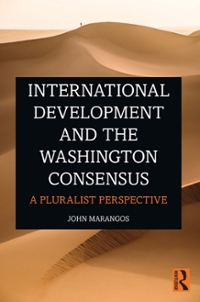Question
1. Consider the Solow model with the production function Y = AF(K,L). Labor force L and productivity factor A are constant unless specifically stated otherwise.
1. Consider the Solow model with the production function Y = AF(K,L). Labor force L and productivity factor A are constant unless specifically stated otherwise. Suppose that originally the economy is in the steady state. Demonstrate on the graph and explain intuitively what happens to output per capita in the following situations. Make sure you indicate what happens on impact, in the transition period, and in the new steady state. Explain intuition. a. An increase in the depreciation rate of capital b. Destruction of a share of capital stock due to a natural disaster c. A technological breakthrough (increase in A)
2. Consider the Solow model with constant population and no technological progress. The production function is Y = KL1-. The saving rate is denoted by s, the depreciation rate by . a. Derive the expression for production function in per capita terms, y = f(k), where y Y/L and k K/L b. Find the expression for the steady-state level of k as a function of exogenous parameters s, , and . c. Now find the Golden Rule level of steady state k (i.e., the level that maximizes steady state consumption). Combine it with the result in (b)to find the Golden Rule saving rate as a function of exogenous parameters. d. It is normally believed that the share of capital in total income in the US economy is 1/3, so = 1/3. The standard estimate for the depreciation rate is = 0.05. Find the Golden Rule saving rate for these numbers. The actual investment rate in the US economy has been about 21%. Based on this exercise, does it look like the US economy is investing too much, too little, or just enough? e. Now find the expression for steady state income as a function of exogenous parameters s, , and . Suppose again that = 1/3 and = 0.05. Compare income for the case when saving rate is 5% and 50%. Based on your finding, do you think that differences in the saving rate can possibly explain the differences in levels of income that we observe between countries? 3. Now consider the Solow model with population growth and technological progress. a. Suppose the rate of population growth increases. Demonstrate what happens on the graph of the model. If the new steady state is below the original one, does that mean that people are worse off in terms of their income? Why? b. Repeat the same exercise with an increase in the rate of technological progress. Again, if the new steady state is below the old one, does that mean that people are worse off?
4. Consider the steady state of the Solow model with population growth and technological progress. The production function is Y = F(K,EL), and the per capita production function is f(k) = F(k,1), where k is defined as K/EL. E grows at the rate g, while L grows at the rate n. a. (Optional) The marginal product of capital is defined as partial derivative of F(K,EL) with respect to K. Demonstrate that it also equals f'(k), that is, derivative of the function f(k). If you cannot demonstrate it, just proceed with the new definition MPK = f'(k). b. Using the result in (a), demonstrate that the share of capital income in the economy (and therefore share of labor income as well) stays constant on the steady state growth path. c. From here demonstrate at which rate the real rental price of capital and the real wage should grow in the steady state. d. Let us get back to the equation MPK = PK/P(r+). In the long run, the prices of investment and consumption goods should equalize, so PK/P=1. In that case, what does the Solow model predict about long-run behavior of the real interest rate? 5. Now let us link the Solow model with the labor market and market for capital. a. Suppose there is no population growth and no technological progress. Also suppose that economy starts from below steady state level of capital and approaches the steady state. Demonstrate what happens in the labor market and market for capital during this process. What happens to the real wage and rental price of capital? Show on graphs and explain intuition. b. Now suppose economy is in the steady state, and there is population growth, but no technological progress. Show what happens on those graphs now. Does this correspond to your results in the previous problem? c. Finally, repeat the same exercise for the situation when the economy is in the steady state, in which there is technological progress but no population growth.
Step by Step Solution
There are 3 Steps involved in it
Step: 1

Get Instant Access to Expert-Tailored Solutions
See step-by-step solutions with expert insights and AI powered tools for academic success
Step: 2

Step: 3

Ace Your Homework with AI
Get the answers you need in no time with our AI-driven, step-by-step assistance
Get Started


